 My colleague Sam Millette, manager, fixed income on Commonwealth’s Investment Management and Research team, has helped me put together this month’s Market Risk Update. Thanks for the assist, Sam!
My colleague Sam Millette, manager, fixed income on Commonwealth’s Investment Management and Research team, has helped me put together this month’s Market Risk Update. Thanks for the assist, Sam!
December was a solid month for equity markets, as all three major U.S. indices capped off the year with positive results. The S&P 500 gained 4.48 percent during the month, while the Dow Jones Industrial Average (DJIA) notched a 5.53 percent return. The Nasdaq Composite lagged due to a heavy concentration in technology stocks; however, the index still managed to gain 0.74 percent for the month. The story was much the same internationally, as the MSCI EAFE Index gained 5.12 percent while the MSCI Emerging Markets Index experienced a 1.92 percent increase. Despite the positive results in December, risks to markets remain and should be carefully monitored as we kick off the new year.
Recession Risk
Recessions are strongly associated with market drawdowns; in fact, 8 of 10 bear markets have occurred during recessions. The National Bureau of Economic Research, which declared that a recession started in February 2020 when markets plunged, announced that it ended shortly thereafter. Despite that and the ongoing expansion since then, economic risks remain. The primary risk is a slowing recovery, as evidenced by the slowdown in job growth in November and December 2021.
On the whole, the economic recovery continued in December, although uncertainty about the path of the recovery increased during the month due to rising medical risks. Given the remaining risks, we have kept the economic risk level at a yellow light for now. Although the most likely path forward is continued recovery, the slowdown in job growth in December is a reminder that the pace of the recovery remains uncertain and that we will likely see setbacks along the way.
Economic Shock Risk
One major systemic factor is the price of money, otherwise known as interest rates. They drive the economy and financial markets—and, historically, have been able to derail them. Rates have been causal factors in previous bear markets and deserve close attention.
Risk factor #1: The yield curve (10-year minus 3-month Treasury rates). We cover interest rates in the economic update, but they warrant a look here as well.
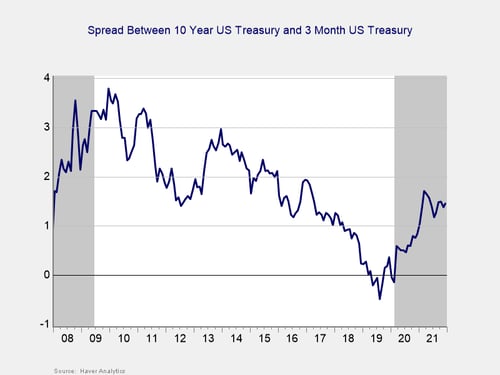
The yield curve steepened moderately in December. This result was due to rising long-term interest rates, as the 10-year Treasury yield increased from 1.43 percent at the end of November to 1.52 percent at the end of December. The three-month Treasury yield increased from 0.05 percent at the end of November to 0.06 percent at the end of December. The current spread of 1.46 percent is in line with the levels we saw in September and October.
The increase in long-term Treasury yields during the month was largely due to rising expectations for tighter monetary policy from the Fed. Economists largely expect to see the Fed work to combat inflation in 2022, which could lead to more frequent rate hikes as the central bank tries to normalize monetary policy.
While this normalization process is a good sign for the ongoing economic recovery, rising rates can have a negative effect on stocks, as we saw in the first quarter of 2021. Long-term yields have continued to rise in January, and we’ve seen market turbulence to match. Given the potential negative impact from rising rates on equities, we have downgraded this signal to yellow for now with a potential downgrade to red possible in the months ahead.
Signal: Yellow light
Market Risk
Beyond the economy, we can also learn quite a bit by examining the market itself. For our purposes, two things are important:
- To recognize which factors signal high risk
- To try to determine when those factors signal that the risk has become an immediate—rather than theoretical—concern
Risk factor #1: Valuation levels. When assessing valuations, we find longer-term metrics (particularly the cyclically adjusted Shiller P/E or price-to-earnings ratio, which looks at average earnings over the past 10 years) to be the most useful in determining overall risk.
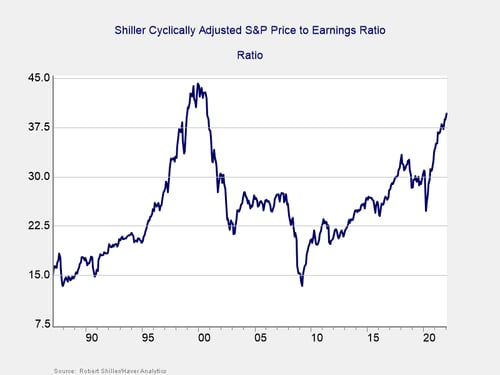
Valuations continued to rise in January, as the Shiller CAPE ratio rose from 38.68 in December to 39.60 in January. This result brought the Shiller CAPE ratio to its highest level since late 2000.
Even though the Shiller CAPE ratio is a good risk indicator, it’s a terrible timing indicator. To get a better sense of immediate risk, let’s turn to the 10-month change in valuations. Looking at changes rather than absolute levels gives a sense of the immediate risk level because turning points often coincide with changes in market trends.
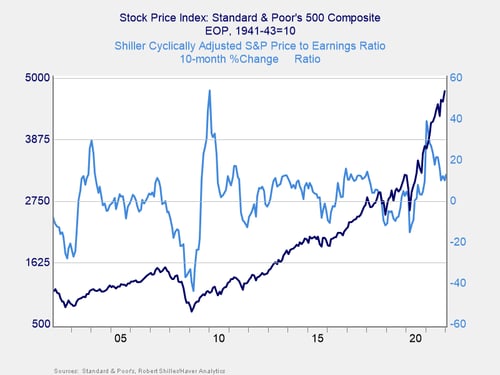
Above, you can see that when valuations roll over—with the change dropping below zero over a 10-month or 200-day period—the market itself typically drops shortly thereafter. This relationship held at the start of the pandemic, as valuations and the index rolled over before rebounding. On a 10-month basis, valuations rose 13.01 percent in January, up from the 10.2 percent increase we saw in December. Given the historically high valuation levels, we have kept this indicator at a yellow light for now, despite the fact that valuation changes have remained outside the danger zone since May 2020.
Signal: Yellow light
Risk factor #2: Margin debt. Another indicator of potential trouble is margin debt.
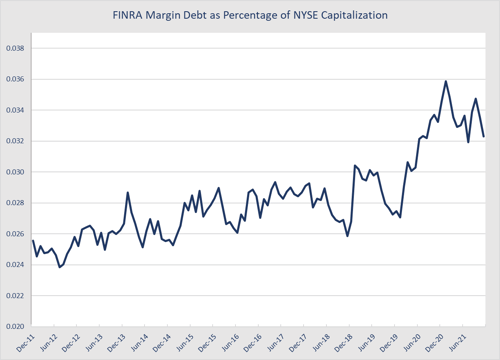
Debt levels as a percentage of market capitalization increased notably at the start of the pandemic and throughout 2020. Since then, we have seen margin debt largely decline from the recent highs that we saw in late 2020. Margin debt declined for the second straight month in November following increases in August and September; however, the overall level of margin debt remains high on a historical basis. The high level of debt associated with the market is a risk factor on its own but not necessarily an immediate one.
For immediate risk, changes in margin debt over a longer period are a better indicator than the level of that debt. Consistent with this, if we look at the change over time, spikes in debt levels typically precede a drawdown.
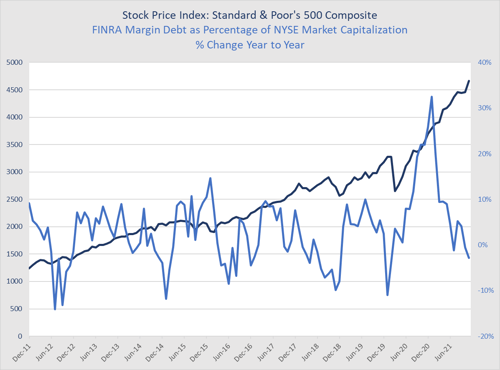
As you can see in the chart above, margin debt as a percentage of market capitalization declined by 2.82 percent on a year-over-year basis in November. This follows a 0.53 percent year-over-year decline in margin debt in October and marks the first time we’ve seen consecutive months with declining year-over-year margin debt since the start of the pandemic.
Although margin debt as a percentage of market capitalization declined on a year-over-year basis in October, the high absolute level of margin debt as a percentage of market capitalization is worth monitoring. We have kept this indicator at a yellow light for now.
Signal: Yellow light
Risk factor #3: Technical factors. A good way to track overall market trends is to review the current level versus recent performance. Two metrics we follow are 200-day and 400-day moving averages. We start to pay attention when a market breaks through its 200-day average, and a breakthrough of the 400-day average often signals further trouble ahead.

Technical factors remained supportive for equity markets throughout December. The S&P 500, which managed to break above its 200-day moving average at the end of May 2020, has finished above-trend every month since. The DJIA and Nasdaq Composite have seen similar technical support; however, the DJIA did come close to hitting its trend line due to the pullback at the end of November before rebounding to finish the year strong.
The 200-day trend line is an important technical signal that is widely followed by market participants, as prolonged breaks above or below could indicate a longer-term shift in investor sentiment for an index. The 400-day trend line is also a reliable indicator of a change in trend. The continued technical support for markets, despite volatility during the month, was encouraging, so we have left this signal at a green light.
Signal: Green light
Risk factor #4: Market complacency. This is a recently added risk factor that aims to capture a standardized measure of market complacency across time. Complacency can be an uncertain term, so this chart identifies and combines two common ways to measure complacency: valuations and volatility.
For the valuation component of the index, we are using the forward-looking price-to-earnings ratio for the S&P 500 over the next 12 months. This gives an idea of how much investors are willing to pay for companies based on their anticipated earnings. Typically, when valuations are high, it signals investors are confident and potentially complacent. For volatility, we have used the monthly average level for the VIX, a stock market volatility index. When volatility for the S&P 500 is high, the VIX rises, which would signal less complacency.
By combining the two metrics in the chart below, we see periods where high valuations and low volatility have caused peaks, such as 2000, 2006–2007, and 2017. We saw market drawdowns within roughly one year following each of these peaks.
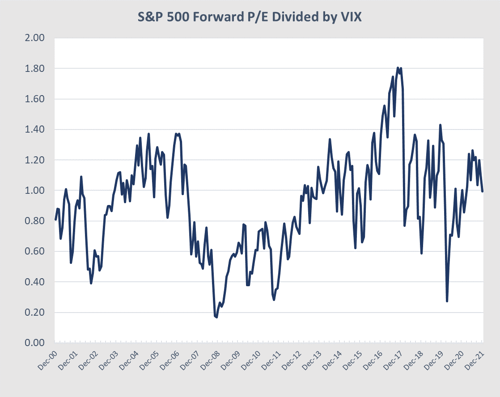
Source: Haver Analytics, FactSet
Looking at the current chart, market complacency dropped in December. The average VIX reading increased from 18.5 in November to 21.4 in December. The forward-looking P/E ratio for the S&P 500 also increased, rising from 20.4 in November to 21.2 in December. The increase in average volatility in December was more than enough to offset the rise in valuations during the month. This caused the market complacency index to decline from 1.10 in November to 0.99 in December, which marks the lowest level for the index since February 2021.
Readings exceeding 1.2 have historically been a signal that market complacency may be at concerning levels, so the continued pullback for the index in December is a sign that complacency fell back from the potential danger zone that we hit in October. With that being said, the index has spent the past few months near this historically concerning level, and it’s too early to say that we are out of the woods in terms of market complacency. Therefore, we have left this signal at a yellow light for now.
Signal: Yellow light
Conclusion: Risks Remain Despite Strong Year for Markets
While the markets rebounded and the economic recovery continued in December, the indicators that we monitor in this piece serve as reminders that risks for the market remain. Interest rates continue to be a potential cause of concern for equity markets, as we’ve seen through the start of January. Additionally, political and medical risks are very real and should be monitored.
With that being said, the most likely path forward is for continued market appreciation in the months ahead, provided we see continued economic growth.
Ultimately, the path back to a more normal economic environment will likely be long, and we can expect setbacks along the way. Given the fact that the indicators we track in this update remained at a yellow light or better during the month, we have left the overall market risk level at a yellow light for now; however, the recent rise in uncertainty could lead to further volatility and downgrades in the months ahead.



 Print
Print

